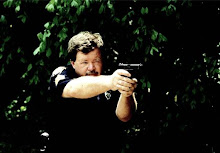

Bank Security
Often we are warned of the danger of late night excursions to the automated teller machine. It is a patently bad idea to retrieve cash after dark. Night deposits are not a good idea either. No matter how well armed you are a .32 in the brain case fired by one of our protein fed ex con criminal class stepping out of the bushes is deadly. Just the same, daylight business conducted at the bank is also fraught with the possibility of peril. If something bad occurs at the bank it is often very, very bad. It doesn’t really matter if the bank is isolated or not, although the banks closest to interstate connectors seem much more attractive to robbers. Bank robbers are not always street punks. The fact is they are often well armed and have practiced with their weapons. They may even had some sort of plan. Often they have a partner in crime stationed nearby.
I have encountered a few bank robbers in my life and arrested one, although it was after the fact. Like safe crackers they are more sophisticated than the general run of thugs. Bank robbers are often more sober and collected than the lower class stick up man. As a result, they are less likely to panic and spray bullets, but if they feel they must shoot they are often more deadly than typical stick up man. The police response to alarms at the bank varies. For every robbery in progress cal that is real there may be a dozen false alarms in some jurisdictions. Cops sometimes simply walk into a bank and look around to check out the alarm! I kid you not. Just the same if you are armed now is the time to play it cool. Armed citizens should be alert to the possible danger of entering a bank. Some of us feel comfortable in the bank, and safe. I do not relax my guard in the bank, rather I move up a notch or two in threat awareness.
Many (unsolved) tragedies have occurred at banks. It seems that if a robbery occurs at the bank when there are only a few customers the chances are much greater the robber will kill all that are present in order to eliminate potential witnesses. I should stress that it might be a bad idea to attempt to stop a robbery with gunfire. If the robber is motivated by profit he may simply take the money and run. Your money is insured. I don’t think you wish to draw a snub .38 against an armored adversary.
Sometimes folks rush to the bank. Don’t. I have seen people with a handful of cash rush into the bank with hardly a sideways look. Bank robbers have lookouts. I have dealt with drug dealer and burglar lookouts successfully. They are not that hard to spot. If you see someone suspicious in the bank parking lot, then be extra alert. Perhaps even wait to do the business another day or at another branch. If nothing is out of the way in the parking lot, take a look in the bank before you enter. Most now feature glass fronts, it is easy enough to peek in. Check and see if the tellers are composed. Some actually smile. The demeanor of the teller is a good indication of the situation inside the bank.
Once inside I like to keep my eye on the door. It is true that the robber is often more interested in the teller than the customers but if you are situationally aware and make eye contact with a potential threat he may decide you are a danger to his enterprise. Remember they are often good at spotting trouble. While criminals are stupid they are not dumb.
I have heard trainers exhort their students to be constantly aware but to remain calm. Aware and relaxed are the watchwords. I think that we may jack up the awareness a notch or two inside such an attractive target. Many robberies, in fact the majority, involve no bloodshed. But a nervous robbery may produce a bloodbath. Not long ago an officer in the Northern United States engaged two robbers in gunfire and hit both, but was killed during the gun battle. Bank robbery is a grim business. Bank robbers are perhaps the most prepared of any criminal to fire and take your life. If the robber begins searching or abusing people in the bank, or has fired a shot, then he is motivated by more than profit. You may have to go with what you know. Bank robbers often have a backup who is ready to take out the first armed resistance. That is why if forced to engage you should prefer a back to the wall or covered position. You must fire as accurately as possible and hope for good effect. Be alert for the backup man on the team.
Expect the police to arrive with drawn guns. You will be ordered to surrender. I would not wish to be standing around with a gun in hand when the boys in blue arrive with guns blazing. Keep the handgun lowered if the robbers are still moving after being shot. If they are no longer a threat holster the handgun and have a bank employee call 911 and explain the situation. Be prepared to identify yourself. A rather important point-if you see armed men charging the bank, are they robbers or undercover officers in the midst of stopping a bank robber? Looks may be deceiving.
While it is not likely you will be caught up in a bank robbery, bank robbery is a fact of life. We deal in possibility as much as probability. Certain cities are bank robbery capitols. It pays to think ahead, address the issue, and consider your options.




























